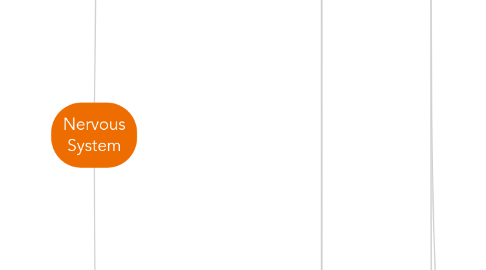
1. CNS
1.1. Brain
1.1.1. The Hindbrain
1.1.1.1. The medulla oblongata
1.1.1.2. The pons
1.1.1.3. The cerebellum
1.1.2. The Midbrain
1.1.2.1. Two pairs of dorsal enlargements
1.1.2.2. The superior and inferior colliculi
1.1.3. The Forebrain
1.1.3.1. Two hemispheres
1.1.3.2. Cerebral cortex
1.1.3.3. Gray matter
1.1.3.4. Basal ganglia
1.1.3.5. Rostral end of the neural tube
1.1.3.6. Diencephalon
1.1.3.7. Thalamus
1.1.3.8. Hypothalamus
1.1.4. CN 12: On Old Olympus Towering Tops, A Fin And German Viewed Some Hops
1.1.4.1. Olfactory
1.1.4.2. Optic
1.1.4.3. Oculomotor
1.1.4.4. Trochlear
1.1.4.5. Trigeminal
1.1.4.6. Abducens
1.1.4.7. Facial
1.1.4.8. Auditory (Vestibulocochlear)
1.1.4.9. Glossopharyngeal
1.1.4.10. Vagus
1.1.4.11. Spinal Accessory
1.1.4.12. Hypoglossal
1.2. Spinal Cord
1.3. Receptors
1.3.1. Mu Receptors
1.3.1.1. Location
1.3.1.1.1. CNS
1.3.1.2. Function
1.3.1.2.1. Analgesia
1.3.1.2.2. Respiratory Depression
1.3.1.2.3. Euphoria
1.3.1.2.4. Sedation
1.3.2. Kappa Receptors
1.3.2.1. Location
1.3.2.1.1. CNS
1.3.2.2. Function
1.3.2.2.1. Analgesia
1.3.2.2.2. Sedation
1.3.3. Serotonin
1.3.4. GABA
1.3.4.1. GABA is an Inhibitory neurotransmitter that is widely distributed throughout the brain
1.3.5. Glutamate
1.3.5.1. Glutamate is the primary excitatory neurotransmitter in CNS
1.3.5.2. Works on 2 receptors: NMDA and AMPA
1.3.6. Opioid Analgesics and Antagonists
1.3.6.1. Pure Opioid Agonists: activate Mu and Kappa.
1.3.6.1.1. Morphine
1.3.6.1.2. Fentanyl
1.3.6.1.3. Oxycodone
1.3.6.1.4. Hydrocodone (vicodin)
1.3.6.2. Agonist-Antagonist Opioids: produce analgesia.
1.3.6.2.1. Agonist on Kappa, Antagonist on Mu
1.3.6.2.2. Limited response of respiratory depression, increases workload on heart
1.3.6.3. Pure Opioid Antagonists: Naloxone. Reversal of overdose
1.3.6.3.1. Drugs which block the effects of opioid agonist @ Mu receptor
1.3.6.3.2. Treatment of opioid overdose
1.3.6.3.3. Reversal of coma and respiratory depression
1.3.6.3.4. Relief of opioid induced constipation
1.3.6.3.5. Management of addiction
1.3.6.3.6. Narcan
1.4. CNS DRUGS
1.4.1. Antiepileptics
1.4.1.1. Suppression of Sodium Influx
1.4.1.1.1. Activated state: Na+ influx into the cell
1.4.1.1.2. Inactivated state: After Na+ entry; cells are closed
1.4.1.1.3. Normal: quickly return to activated state
1.4.1.1.4. Medications: Reversibly bind to Na+ channel while they are in the inactivated state, prolonging inactivation
1.4.1.2. Suppression of Calcium Influx
1.4.1.2.1. In axon terminals, influx of Ca+ through voltage gated Ca+ channels promotes transmitter release
1.4.1.2.2. Drugs block this and suppress transmitter release
1.4.1.3. Promotion of Potassium Efflux: affect of repolarization
1.4.1.3.1. Ezogabine
1.4.1.3.2. Medication that acts on voltage gated K+channels to facilitate K+ efflux; slows repetitive neuronal firing
1.4.1.4. Antagonism of Glutamate: primary excitatory transmitter
1.4.1.4.1. Glutamate is the primary excitatory neurotransmitter in CNS
1.4.1.4.2. Works on 2 receptors: NMDA and AMPA
1.4.1.4.3. Drugs block the action of glutamate
1.4.1.5. Potentiation of GABA: decrease neuronal excitability
1.4.1.5.1. GABA is an Inhibitory neurotransmitter that is widely distributed throughout the brain
1.4.1.5.2. Drugs decrease neuronal activity, suppressing a seizure
1.4.2. Antipsychotics
1.4.2.1. FGAs
1.4.2.1.1. Block receptors for dopamine in the CNS
1.4.2.1.2. Cause serious movement disorders (Extra Pyramidal Symptoms EPS)
1.4.2.1.3. Classified by Potency
1.4.2.1.4. Adverse Effects
1.4.2.1.5. Toxicity
1.4.2.2. SGAs
1.4.2.2.1. Produce only moderate blockage of dopamine receptors; stronger blockage for serotonin
1.4.2.2.2. Less risk of EPS than FGAs
1.4.2.2.3. Mechanism of action
1.4.2.2.4. Therapeutic use
1.4.2.2.5. Pharmacokinetics: rapid absorption after oral administration, highly protein bound, hepatic metabolism, renal and fecal excretion
1.4.2.2.6. Adverse effects: Agranulocytosis, Seizures, DM
1.4.2.3. Atypical Antipsychotics
1.4.2.3.1. Risperidone (Resperdal)
1.4.2.3.2. Mechanism of action:
1.4.2.3.3. Pharmacokinetics: rapid absorption, hepatic met., renal excretion, long half life
1.4.2.3.4. Therapeutic effects: Treatment of Schizophrenia and Bipolar disorder
1.4.2.3.5. Adverse effects:
1.4.2.4. Depot Preperations
1.4.2.4.1. Long-acting, injectable formulations used for long-term maintenance therapy of schizophrenia
1.4.2.4.2. Three depot preparations available
1.4.3. Depression Drugs
1.4.3.1. SSRIs
1.4.3.1.1. Produce selective inhibition of serotonin reuptake
1.4.3.1.2. Produce CNS excitation
1.4.3.1.3. Primarily used to treat major depression
1.4.3.1.4. Other uses
1.4.3.1.5. Adverse Effects
1.4.3.1.6. Drug Interactions
1.4.3.2. SNRIs (Venlafaxine)
1.4.3.2.1. Indications
1.4.3.2.2. Blocks NE and serotonin uptake
1.4.3.2.3. Serious reactions if combined with MAOIs
1.4.3.2.4. Side effects
1.4.3.3. Tricyclic Antidepressants (TCAs)
1.4.3.3.1. Drugs of first choice for many patients with major depression
1.4.3.3.2. Most common adverse effects: sedation, orthostatic hypotension, and anticholinergic effects
1.4.3.3.3. May increase risk of suicide early in treatment
1.4.3.3.4. Block neuronal reuptake of two monoamine transmitters
1.4.3.3.5. Indications
1.4.3.3.6. Other uses
1.4.3.3.7. Side Effect
1.4.3.3.8. Toxicity
1.4.3.4. MAOIs
1.4.3.4.1. 2nd- or 3rd-choice antidepressants for most patients
1.4.3.4.2. As effective as TCAs or SSRIs, but more dangerous
1.4.3.4.3. Risk of triggering hypertensive crisis if patient eats foods rich in tyramine
1.4.3.4.4. Drug of choice for atypical depression
1.4.3.4.5. Therapeutic uses
1.4.3.4.6. Adverse effects
1.4.3.4.7. Hypertensive Crisis with Dietary Tyramine
1.4.3.5. Atypical Antidepressants
1.4.3.5.1. Bupropion (Wellbutrin)
1.4.4. Bipolar Disorder Drugs
1.4.4.1. Mood stabilizers (Lithium)
1.4.4.1.1. Relieve symptoms during manic and depressive episodes
1.4.4.1.2. Do not worsen symptoms of mania or depression; do not accelerate the rate of cycling
1.4.4.1.3. Prevent recurrence of manic and depressive episodes
1.4.4.1.4. Lithium
1.4.4.2. Antipsychotics
1.4.4.2.1. Given during severe manic episodes
1.4.4.3. Antidepressants
1.4.4.3.1. Given during depressive episodes
1.4.5. Sedative-Hypnotic Drugs
1.4.5.1. Drugs that depress CNS function
1.4.5.2. Primarily used to treat anxiety and insomnia
1.4.5.3. Antianxiety agents or anxiolytics
1.4.5.4. Distinction between antianxiety effects and hypnotic effects is often a matter of dosage
1.4.6. Panic Disorder Drugs
1.4.6.1. Antidepressants
1.4.6.1.1. Selective serotonin reuptake inhibitors
1.4.6.1.2. Tricyclic antidepressants
1.4.6.1.3. Monoamine oxidase inhibitors
1.4.6.2. Benzodiazepines
1.4.6.2.1. Drugs of choice to treat insomnia and anxiety
1.4.6.2.2. Used to induce general anesthesia
1.4.6.2.3. Used to manage seizure disorders, muscle spasm, panic disorder, and withdrawal from alcohol
1.4.6.2.4. Safer than general CNS depressants
1.4.6.2.5. Potential for abuse
1.4.6.2.6. Fewer drug interactions
1.4.6.2.7. Adverse effects
1.4.7. Insomnia Drugs
1.4.7.1. Drugs used for treatment
1.4.7.1.1. Benzodiazepines
1.4.7.1.2. Benzodiazepine-like drugs: zolpidem (ambien), zaleplon, and eszopiclone (lunesta)
1.4.7.2. Ramelteon melatonin agonist
1.4.7.3. Trazodone
1.4.7.3.1. Causes excessive fatigue. Use with caution in elderly
1.4.7.4. Antihistamines
1.4.7.4.1. No longer used in children. Benadryl
1.4.7.5. Alternative medicines
1.4.7.5.1. melatonin
1.4.7.6. Sleep hygiene
2. PNS
2.1. Motor
2.1.1. Somatic
2.1.2. Autonomic
2.1.2.1. Parasympathetic
2.1.2.2. Sympathetic
2.1.3. Receptors
2.1.3.1. Adrenergic
2.1.3.1.1. Alpha 1
2.1.3.1.2. Alpha 2
2.1.3.1.3. Beta 1
2.1.3.1.4. Beta 2
2.1.3.1.5. Dopamine
2.1.3.1.6. Adrenergic DRUGS
2.1.3.2. Cholinergic
2.1.3.2.1. Nicotinic N
2.1.3.2.2. Nicotinic M
2.1.3.2.3. Muscarinic
2.1.3.2.4. Cholinergic DRUGS
